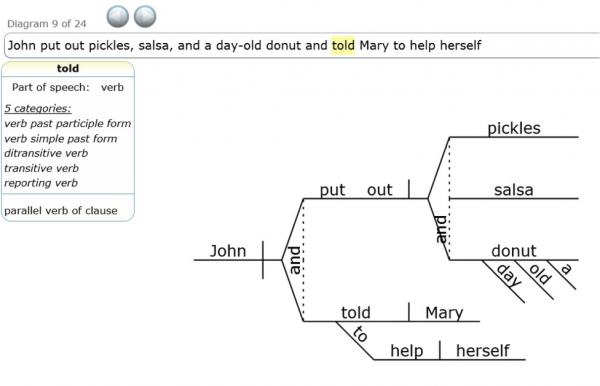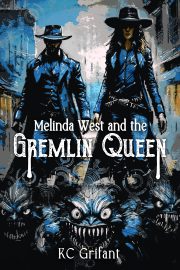A Tool for Exploring Hidden Dimensions
A Feynman diagram of particle interactions it’s not, but English majors can still take heart. Behold, the glory of a complex sentence.
by Dennis Mathis
 I’ve been trying to educate myself about higher dimensions (that is, beyond x, y, z, and t), and I’m here to congratulate myself on slogging through an explanation of string theory’s implications that the universe might have 10 or 11 dimensions. I read every word of Warped Passages: Unraveling the Mysteries of the Universe’s Hidden Dimensions by Lisa Randall.
I’ve been trying to educate myself about higher dimensions (that is, beyond x, y, z, and t), and I’m here to congratulate myself on slogging through an explanation of string theory’s implications that the universe might have 10 or 11 dimensions. I read every word of Warped Passages: Unraveling the Mysteries of the Universe’s Hidden Dimensions by Lisa Randall.
I do recommend the book. The glossary, which could generate names for dozens of hi-tech startups, is alone worth the price.
There’s an asterisk to my recommendation, however. The book jacket promises, “There might be another universe adjacent to ours, invisible and unattainable… for now.” But the book never told me the one thing I wanted to know: How to get there.
I could also quibble with someone’s decision (I blame the editors) to begin each chapter with an allegory involving characters named Athena or Ike Rushmore getting off elevators and subways somewhere unnatural. As narrative, these stories fall a few orders of magnitude short of satisfying.
Dr. Randall’s specialty is modeling what theorists posit — running the numbers and seeing how the results match up with observed phenomenon. I suspect that isn’t just chalkboard stuff. There are probably supercomputer visualizations involved nowadays.
What Dr. Randall isn’t good at, alas, is conveying those visions through storytelling, deprived of Greek letters and dingbats. It’s not her fault. It’s a fundamental barrier: math is math, not something else.
* * *
Take the concept of “curled up,” compacted, unobserved-because-irrelevant dimensions. The book’s explanation is reasonable — if a cocktail straw is stretched a mile long, it would appear to be a one-dimensional line. But for an amoeba crawling a spiral path inside the straw, it’s also a vast flat prairie.
I can absorb that much… but then I snap back to the realization that I’ve only succeeded in visualizing something complicated in 3-D: an elongated toroid. And frankly, the tough part was picturing a pure one-dimensional line. I don’t come across many of those in daily experience, compared to cocktail straws.
I haven’t learned a thing about a fifth dimension. How could it be rolled up like a straw if it’s everywhere, attached to every quark, intersecting with x, y, z, and t at every coordinate? Unless it’s not so much a dimension as a quality, a variable measured on some other scale. That doesn’t seem so uncommon.
* * *
Dr. Randall should leave surrealism to professionals. If there’s one thing English majors are good at, it’s smashing up ludicrously dissimilar concepts and reading significance out of the jumble. John Updike once compared Jesus’ eyelids, as seen by Japanese villagers, to the armpits of a lizard. What makes this a successful simile is the bizarre moment when we realize, I always thought that about Jesus’ eyelids.
That’s what a good analogy for higher dimensions should achieve, I think. Suddenly you see what was always there.
* * *
Sometimes an analogy is staring you in the face.
Suppose the fundamental particle of the universe is a meaningless squiggle with no dimension to speak of. It can take on, let’s say, about 30 configurations. Let’s call it a “letter.” These squiggles attract each other, but in a broken-symmetry way — only to the right. They tend to clump up into “words,” and then words clump sequentially together in larger structures called “sentences,” and the sentences crystalize into “paragraphs,” always to the right, always a one-dimensional line.
Ignoring line wraps, paragraph returns, and chapter breaks, Dr. Randall’s book is a mile-long (I calculated) gray thread. Viewed full-length it would be as one-dimensional as anything I can imagine, and yet curled up within it is a compendium of all we know or suspect about space and time, the universe, and everything. The book contains “the bulk” (to use a term I learned from it), at least wherever the true universe intersects a line of ink squiggles.
* * *
It’s the unrelenting linearity of writing that has always irritated me. For the first thirty-five years of life I was not a good typist, so for me writing has always felt as tedious as stringing beads.
One-dimensionality is the defining feature of the written word as an art form. I can take in a painting or one view of a sculpture all at once; I can perceive layers and depth in a passage of music. I can whistle a Bach fugue. But I can never hold the entire shape of a piece of writing in my head.
Being within a sentence, as writer or a reader, is like riding a train: All I can see is the compartment I’m in, with maybe a glimpse of the car in front or behind. I’d need a periscope to see the whole structure from locomotive to caboose — but of course that’s what reading is, the ability to rise up high enough in another dimension to see the structure and continuity of a sentence, or the switching yard of a paragraph.
* * *
There happens to be a tool for exploding a sentence into two dimensions. You probably already know about it.
Reed-Kellogg sentence diagrams, introduced in 1877 by Alonzo Reed and Brainerd Kellogg, were an agonizing part of every schoolchild’s experience for many generations, but exposure to the system seems to have dropped from curricula in recent years, except perhaps among home-schooling advocates who favor notoriously traditional, prescriptive methods.
The irony is that it’s never been easier to convert a string of text into a 2-D architectural diagram according to Reed-Kellogg’s system. At 1aiway.com, you’ll find an online gadget (requires Microsoft Silverlight plug-in; there’s also a downloadable app) that not only takes the pain out of the analysis but, if you’re like me, turns sentence diagramming into an almost guilt-free time-waster. Simply plug in a sentence and hit return, and the app does a decent job of generating the diagram.
Mike Gross and his colleagues at Nlp4net developed the app as a stepping stone toward a grander concept, “a technology to close a communication gap between machines and people, so we can talk plain text while machines talk objects,” which Mike admits “never took off so we killed it and moved on.” Fortunately for us, they left behind a solid, if imperfect, Reed-Kellogg engine for us to play with.
The app’s success rate is surprisingly high. If it can parse the sentence at all, it generates at least one and sometimes many diagrams. Then the game becomes figuring out which is the most accurate while enjoying a moment of human pride watching machine logic struggle with the oddities of natural language.
I’ve logged enough time noodling with the app that I’ve got a short story going featuring my generic subjects, John Lorem and Mary Ipsit, star-crossed lovers on the most boring date in grammar history. For example, John put out pickles, salsa, and a day-old donut and told Mary to help herself results in 24 possible diagrams. The ninth strikes me as the most accurate:
Notice that when you roll over a word, a popup appears detailing some of its grammar technicalities. This would be quite educational, no doubt, if I were actually motivated enough to find out what a ditransitive verb is.
A Feynman diagram of particle interactions it’s not, but English majors can still take heart. Behold, the glory of a complex (or is it compound?) sentence — the parallelism of pickles, salsa, donut floating over the nested statement encapsulating what John told Mary.
Still, I yearn for even more dimensions, a diagram in a cube at least, which 3-D printing could easily accommodate nowadays. Shouldn’t there be a way to make evident the distinction between past and future, or simple past and past perfect? Couldn’t there be a way to picture the virtual reality of subjunctive mood, that would-could-should-might state of imaginable events that haven’t happened in this particular universe?
If there are higher dimensions, I could almost convince myself I’m looking at them.



